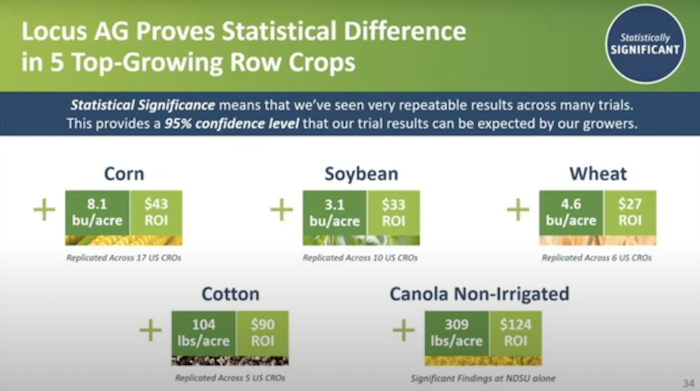Biologicals are gaining recognition as a vital solution to some of the biggest problems facing farmers today. But with all the options on the market, how do you know which one to choose? Locus Ag addressed that question during a digital demonstration with Strip-Till Farmer. Here are 5 big takeaways from the presentation.
Biologicals Are Like Probiotics for Crops
Biologicals are defined as a diverse group of agricultural products made from living, naturally occurring microorganisms as the primary active ingredient that are used to increase soil fertility, nutrient uptake and yield. Chris Lidgett, director of sales for Locus Ag, says strip-tillers can expect the following benefits from using biologicals in their operation:
- Nitrogen fixation
- Expanded root growth
- Increased nutrient uptake and availability
- Better crop quality and productivity
- Soil carbon sequestration and storage
- Higher yields & ROI
“The purpose of the biological is to give the crops the best chance to thrive by improving the quality of the soil they’re grown in,” Lidgett says. “It’s not meant to replace any other inputs, but it’s meant to complement your fertilizers. Think of it as your yogurt probiotic, but only for your crops.”
More Strains Does Not Equal a Better Product
Common strains used in biological products include bacteria (Bradyrhizobium, Rhizobium, Streptomyces, Bacillus), fungi (Trichoderma, Mycorrhizae) and yeast (Wickerhamomyces). But biologicals that contain higher numbers of these strains often contain weak, ineffective or competing strains, according to Lidgett.
“Not all microbes are compatible with each other,” Lidgett says. “You want to look for complementary strains, tailored to how you’re applying them and what your crops need. It’s not a one-size-fits-all and ‘more is better’ situation. Our products are designed to have 1-4 strains per product.
WATCH: Locus Ag hosts a digital demonstration, "Benefit with Biologicals"
Higher Application Rate Doesn’t Equal a Better Product
Just because you’re applying biologicals at a higher rate, doesn’t necessarily mean it will give you more bang for your buck, according to David Dyson, lead agronomist for Locus Ag.
Dyson says you need to pay attention to Colony Forming Units (CFU) and strain count. Higher CFU counts can be applied at lower rates with better performance, and some products promote high application rates without the data to support it.
“There are some products that only require a half an ounce per acre, and some require a gallon per acre,” Dyson says. “Just make sure that you check your CFUs because they can water it down. Most Locus products are highly concentrated. That’s why we can do a lower use rate. Check out the data too, because that will support the actual correct rate that you need to use.”
No Additional Equipment is Needed to Apply Biologicals
Strip-tillers interested in using biologicals won’t have to worry about investing in new equipment to do so, Lidgett says.
“Seed coatings are easy to apply, mixed with talc or graphite,” Lidgett says. “It goes directly into your hopper box at planting. It’s endophytic, which means it attaches to the plant for the long-lasting effects.”
Biologicals Boost Corn Yields by 8.1 Bushels Per Acre
Third-party contract research organizations (CROs) and universities tested Locus Ag biological products across 18 states. All trials, which were randomized and replicated, showed that the biologicals boosted yields significantly across different soil types, as illustrated in the graphic below.






